If you’re an educator, chances are that your school or a district has a mission statement that includes words like “innovation,” “problem-solving,” “lifelong learners,” and “global citizens.” These words imply that inquiry-based learning, wonderment, and curiosity are valued by the school. However, what is often unintentionally neglected is how a school’s culture depends on the adults to model and drive the values that the school proclaims. A school’s culture is built and perpetuated not only by interactions among students or between adults and students, but also by interactions between staff, parents, and community members. Curious kids deserve curious adults. Modeling curiosity requires us to be daring, buoyant, and resilient in our own lifelong learning.
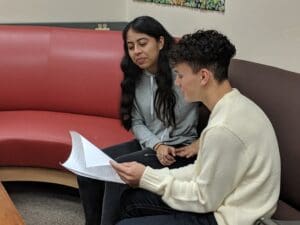 In my initial musings of how to apply the QFT in a library setting, I saw it as a means to involve myself in the question development portion of the research process. However, after taking RQI’s online course hosted by the Harvard Graduate School of Education, “Teaching Students to Ask Their Own Questions: Best Practices in the Question Formulation Technique,” I noticed that I had limited my application of the QFT only to my immediate library setting. My newfound focus not only aimed to rebrand the library by making questions central to learning, but also to nurture a school culture of curiosity that included students, faculty, and administrators.
In my initial musings of how to apply the QFT in a library setting, I saw it as a means to involve myself in the question development portion of the research process. However, after taking RQI’s online course hosted by the Harvard Graduate School of Education, “Teaching Students to Ask Their Own Questions: Best Practices in the Question Formulation Technique,” I noticed that I had limited my application of the QFT only to my immediate library setting. My newfound focus not only aimed to rebrand the library by making questions central to learning, but also to nurture a school culture of curiosity that included students, faculty, and administrators.
I started by sharing the QFT with colleagues so that they could empower students to ask their own questions. But the more I worked on questions in classrooms all over the building, the more I wondered if intentional work on questioning was just as necessary beyond classrooms? I realized that if we expect students to ask questions in the classroom, then teachers should also be willing to pose questions in professional learning contexts such as staff, department, PLCs, and board meetings. Yet, my experience in professional learning settings is that not all adults (and perhaps not very many at all) are asking questions. For teachers, people who are used to having the answers, asking questions and exposing one’s curiosities requires vulnerability. Since questions are opportunities for learning, they also–by nature–indicate that you don’t know something, so teaching others–especially educators– how to question requires a deeper level of trust.
How to Build a Bridge Between Classroom Practice to Sharing the QFT with Colleagues
1. Start with your teacher friends
Whenever I learn a new and relevant teaching tool, strategy, or idea, the first colleagues I share them with are my closest teacher-friends. I do this because I know they value me as a professional, they care about me as a confidant, and we align in our educational philosophy. Kimberly Tahsuda, a Teacher Librarian colleague and Kris Roberts, English Department Chair and Instructional Coach, and I have been collaborating for many years and they were the first people that I shared the QFT with. Together, we discussed how the strategy could be applied, barriers that may arise, how to design an impactful QFocus, and how to apply the generated questions. Then, we teamed up to try the QFT with their classes. We used the opportunity to refine the technique with each other and in return, we built our capacity to execute the QFT with more precision and nuance. Now, Kimberly and Kris are experienced practitioners and together, we designed QFT Template Slides to streamline QFT application for other colleagues.
From there, I visited department meetings for other subject areas such as Social Science, Science, Special Education (SPED), and English Language Development (ELD) and worked with their Professional Learning Communities (PLCs–or Teams). The more I demonstrated my willingness to try new things and make mistakes, the more my colleagues trusted, respected, and valued my instructional skills. It sounds easy, right? Just show up at meetings (that you may or may not be invited to) and your colleagues will see that you have a lot to offer!
2. Invite Colleagues and Administrators to Observe the QFT in Action
When I explain the QFT to colleagues, often it’s difficult for them to conceptualize how they would run it in their classrooms, so I invite colleagues to observe the QFT in action. Often I act as the facilitator with a colleague’s class. This strategy provides a deep sense of comfort and intellectual safety for both the students and the teacher. It is also an opportunity for me to invite others to observe: administrators, teachers from other disciplines, and district instructional coaches. The QFT gained popularity in our district after I shared it with Jay Sorensen, Coordinator of Educational Technology, who applied the QFT in an EdTech context which attracted educators across the district and provided them with a digital QFT template for implementation.

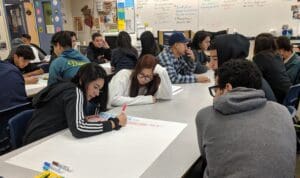
3. Professional Development: Just do it
Armed with my growing (semi) confidence after working with a variety of teachers on lesson design and co-teaching, I felt called to share the QFT with a broader audience and began to put myself out there. When opportunities arose to present at district or county-level professional development days, I signed up. But the act of standing in front of our peers can be extremely intimidating. So many questions of doubt ran through my mind: Will they embrace the QFT? What if they don’t see its value? What if people leave during my presentation? What if they only see me as a librarian and not a teacher? Even though I had done some of the fundamental, collaborative work when I first became a Teacher Librarian and had made a concerted effort to build trust with my colleagues, I was nervous, and insecure about my ability to present on the QFT. To regulate this sense of dread, I did what anyone does when they’re scared to do something–I got my friends to do it too!
I definitely had my reservations about entering the realm of Professional Development, but after co-teaching and co-presenting with trusted, colleague friends, I felt like less of a novice. My first time sharing the QFT by myself with a group of peers felt like jumping into a cold swimming pool. Once I got through that first session, I felt like I had grown as an educator–one who can reach both students and colleagues. Since my first QFT PD, I continue to share at district and county Professional Development days, New Teacher Orientation, and other opportunities as they arise.
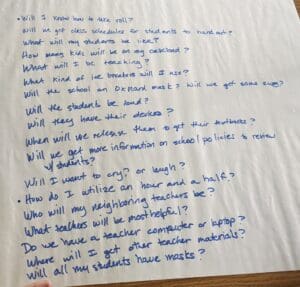
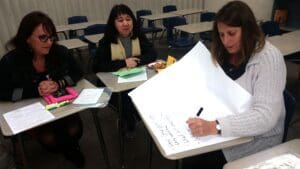
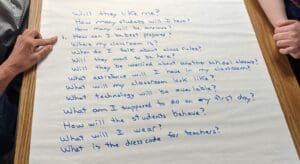
Why Kids and Adults Deserve a Curious School Culture
Encouraging adults’ curiosity among the staff and faculty within a school’s campus culture fosters a dynamic and vibrant educational environment that benefits both students and educators. It promotes continuous improvement, adaptability, and a shared commitment to the pursuit of learning and personal and professional growth. Educational leaders benefit from QFT exposure because they are not only more aware of inquiry practices in the classroom, but they also are more open to soliciting questions from staff members, which translates into a more receptive, inclusive approach to leadership.
Question formulation has become a go-to for helping us as a staff make meaning of new school protocols, programs, or systems:
- New Teacher Orientation→ Entering an unfamiliar school can be overwhelming. At Oxnard High School (OHS), we’ve begun to conduct a QFT with the new teachers to identify any important information that was missed in New Teacher Orientation–this helps teachers organize their questions and concerns and helps administrators differentiate their support. Some questions we have received from new teachers include: “What does a typical day look like? How do I take attendance? What if my students don’t like me? What do I do if there’s a discipline issue in my class?” This practice allows administrators and instructional coaches to be more proactive and responsive to new teachers’ needs.
- Voting for a New School Schedule→ Prior to quarantine, OHS operated on a traditional 6-period schedule; the schedule switched to a 4 period by 4 quarter block for the 2020-2021 school year. Before returning to campus after distance learning, the faculty had to vote on which school schedule model would best suit our students. As you can imagine, passionate parties possessed strong opinions. To facilitate a constructive discussion and to help the teachers make an informed vote, I put together a Q and A Padlet (a digital bulletin board), for teachers to pose questions about the schedule–anonymous or not–and the administrators would answer their questions for everyone to see. I also created another Research Padlet for administrators and teachers to post any articles, data, or testimonials related to the conversation. This method fostered a more productive, transparent, and collaborative process for addressing concerns and offering solutions. Since then, we’ve repeated a similar process to address school safety concerns in 2021 and a new grading policy that was adopted last year.
When the adults on a campus experience the QFT as learners, they feel the power of the discussion and metacognition. They feel safe to share what they do not know, which leads to a trusting, inclusive community that positively influences classroom instruction and school culture. Let’s be clear–there’s still plenty of work to be done to make inquiry a core value at my school. There is sometimes a “let’s get through this as fast as possible,” attitude at meetings or other professional gatherings. But more often, I also notice colleagues wondering and pondering as we discuss school policies, practices, and pedagogy, collaborating with teachers from other schools or disciplines, attempting new teaching strategies, adapting to change, and inspiring students to develop their own curiosity. All the hallmarks, in short, of curiosity. Yet, these goals cannot be achieved without establishing the vital relationships over time that are necessary to make students and staff open enough to put their questions into the world. The relationships that I established with other educators over nine years as a Teacher Librarian, laid the groundwork for promoting inquiry and made me a more capable, conscious professional. When educational leaders embrace a culture of inquiry, we all benefit.
 Jennifer Brickey is the Teacher-Librarian at Oxnard High School. Eight years prior to transitioning to the library position, Jennifer taught a range of English courses at OHS including remedial reading and honors. Since beginning her teaching career, Jennifer has earned a Master’s Degree in Education from Pepperdine University and a Master’s in Library and Information Science from San Jose State University. She prides herself as an educational leader on campus who strives to improve her craft through exploration and application of new teaching strategies and methods. She also regularly designs and facilitates professional development workshops at her school and district. As a South Coast Writing Project Fellow (2011) and an educator rooted in the power of the written word, Jennifer commits herself to the advocacy of literacy, inquiry, and the literary arts. Jennifer has transformed the OHS Library into a cultural hub for the school where students pursue their passions, interests, and curiosities. Find Jennifer on Twitter @Mrs.Brickey or @OHSLibuzzy.
Jennifer Brickey is the Teacher-Librarian at Oxnard High School. Eight years prior to transitioning to the library position, Jennifer taught a range of English courses at OHS including remedial reading and honors. Since beginning her teaching career, Jennifer has earned a Master’s Degree in Education from Pepperdine University and a Master’s in Library and Information Science from San Jose State University. She prides herself as an educational leader on campus who strives to improve her craft through exploration and application of new teaching strategies and methods. She also regularly designs and facilitates professional development workshops at her school and district. As a South Coast Writing Project Fellow (2011) and an educator rooted in the power of the written word, Jennifer commits herself to the advocacy of literacy, inquiry, and the literary arts. Jennifer has transformed the OHS Library into a cultural hub for the school where students pursue their passions, interests, and curiosities. Find Jennifer on Twitter @Mrs.Brickey or @OHSLibuzzy.
